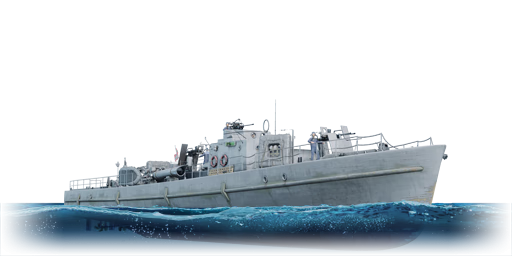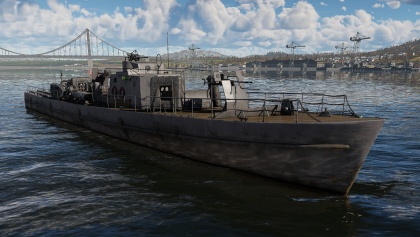R-301
Contents
Description
The R-301-class, R-301 is a rank II German motor torpedo boat
with a battle rating of 2.3 (AB/RB/SB). It was introduced in Update 1.79 "Project X" as part of the fleet closed beta test.
General info
Survivability and armour
The R-301 is constructed using wood, the superstructure is hardened wood constructed to a thickness of 12 mm. The wooden construction of the R-301 means fire is one of the biggest threats to survival of the ship. There is no armour on the ship, apart from the gun shields and hardened superstructure. The R-301 has a crew complement of 42, increased by 1 compared to the R-boot R-130. The R-301 still provides a great attachment of sailors, which helps to increases the overall survivability of the R-301 dramatically compared to other ships in this tier.
Compared to the previous version R-boot R-130 which only offered two single 2 cm/65 C/30 (20 mm) automatic cannons and a single 3.7 cm FlaK-Lafette C/36 (37 mm) automatic cannon. This is now significantly increased even more with two twin 2 cm/65 C/38 (20 mm) automatic cannons, replacing the two single 2 cm/65 C/30 automatic cannons with twice as much stopping power and 200 round magazines for them. Additionally the legendary single 3.7 cm FlaK-Lafette C/36 automatic cannon stays the same the depth charge racks are replaced with two torpedo tubes are added.
However, the internal components of the R-301 are spaced out, meaning a good volley of enemy fire will not completely incapacitate the ship.
- The engine is placed, under the conning tower of the ship, with the transmission extending towards the stern (Rear) to the Voith Schneider propulsion system.
- The transmission & propeller systems are under the waterline which protects it from most enemy rounds, which would penetrate the ship.
- The engines system can be destroyed by enemy fire since it extends above the waterline.
- The ships fuel and ammunition storage can be penetrated by enemy fire, since these are located above the waterline.
Mobility
The R-301 may seem slow in comparison to the other naval ships at this tier, due to its length. The Voith Schneider propulsion system, as found on the R-41 & R-130 has been replaced with a conventional three bladed propeller and transmission system. The engines have been increased from two to three.
The top speed has been increased by the change of propulsion system:
- In arcade it has a maximum speed of 57 km/h.
- In realistic & simulator is 43 km/h.
However, the change from the Voith Schneider to the conventional blades has had a significant change on the manoeuvrability of this ship. It is incapable off performing the once fine manoeuvrable dance acts of the previous Voith Schneider propulsion system, which powered the R-boot R-41 & R-boot R-130.
Armament
Primary armament
Provide information about the characteristics of the primary armament. Evaluate their efficacy in battle based on their reload speed, ballistics and the capacity of their shells. Add a link to the main article about the weapon: {{main|Weapon name (calibre)}}. Broadly describe the ammunition available for the primary armament, and provide recommendations on how to use it and which ammunition to choose.
Secondary armament
Some ships are fitted with weapons of various calibres. Secondary armaments are defined as weapons chosen with the control Select secondary weapon. Evaluate the secondary armaments and give advice on how to use them. Describe the ammunition available for the secondary armament. Provide recommendations on how to use them and which ammunition to choose. Remember that any anti-air armament, even heavy calibre weapons, belong in the next section. If there is no secondary armament, remove this section.
Torpedo armament
Torpedo launchers are standard equipment on many ships and boats. Torpedoes are a significant means of defeating an opponent. Evaluate the position of the torpedo launchers, discuss the ammunition available, firing specifics such as dead zones, features of the torpedoes themselves, etc. If there is no torpedo armament, remove this section.
Special armament
Depth charges, mines, rocket launchers and missiles are also effective in skilled hands and can take an off-guard opponent by surprise. Evaluate the ammunition of this type of armament and rate its performance in combat. If there are no special armaments, remove this section.
Usage in battles
Describe the technique of using this ship, the characteristics of her use in a team and tips on strategy. Abstain from writing an entire guide – don't try to provide a single point of view, but give the reader food for thought. Talk about the most dangerous opponents for this vehicle and provide recommendations on fighting them. If necessary, note the specifics of playing with this vehicle in various modes (AB, RB, SB).
Modules
| Tier | Seakeeping | Unsinkability | Firepower | |||
|---|---|---|---|---|---|---|
| I | Dry-Docking | Tool Set | 20 mm HET magazines | 37 mm Psgr L'spur Zerl | ||
| II | Rudder Replacement | Fire Protection System | Smokescreen | 20 mm APT magazines | Auxiliary Armament Targeting | |
| III | Propeller Replacement | Primary Armament Targeting | ||||
| IV | Engine Maintenance | New Pumps | Mines | Artillery Support | Torpedo Mode | |
Pros and cons
Summarise and briefly evaluate the vehicle in terms of its characteristics and combat effectiveness. Mark its pros and cons in the bulleted list. Try not to use more than 6 points for each of the characteristics. Avoid using categorical definitions such as "bad", "good" and the like - use substitutions with softer forms such as "inadequate" and "effective".
Pros:
Cons:
History
Developed in the inter-war period, the R-Boots (Raumbootes) were designed as minesweepers, and they had deliberately low draughts in order to operate close to the coast. The armament was limited due to the intended mission of the ships. Propulsion was provided by two MAN marine diesel engines, providing 1,836 horsepower each and driving two shafts. Construction utilized a metal understructure and wooden framing.
424 R-Boots were completed, and they continually saw service up until 1945. They were notably used during the 1940 invasion of Norway. Only 140 of these ships survived the war, with many captured by the Allies or divided up between the Allies as spoils of war. 24 R-Boots were eventually reintroduced to the West German Navy and operated until the 1960’s.
The R-Boots, despite being built as minesweepers, were forced into other roles during the war. They were used for search-and-rescue (SAR), ship hunting, coastal patrol, and convoy escort, among other duties such as minelaying. The ships were rarely used in their intended role (minesweeping) because of the defensive nature of the war for the Kriegsmarine.
R-301 was the lead ship of an R-Boot class, significantly larger than the preceding R-218. It had a length of 41 meters and a displacement of 160 tons. This class consisted of R-301 through R-312, and the class was constructed from 1942 to 1945. The biggest change from the preceding classes of R-Boot was the addition of two 533 mm torpedo tubes, for use against enemy surface vessels. The R-301 class also added a third screw for increased speeds, up to 24 knots.
Media
Excellent additions to the article would be video guides, screenshots from the game, and photos.
See also
Links to articles on the War Thunder Wiki that you think will be useful for the reader, for example:
- reference to the series of the ship;
- links to approximate analogues of other nations and research trees.
External links
Paste links to sources and external resources, such as:
- topic on the official game forum;
- encyclopedia page on the ship;
- other literature.
| Germany boats | |
|---|---|
| Motor torpedo boats | LS 3 · LS 4 Esau · KM-5 · VS-10 |
| S-38 · S-38b · S-100 · S-147 · S-204 Lang · S-701 | |
| R-301 | |
| V-990 | |
| Jaguar · Hugin · Pfeil | |
| Motor gun boats | R-41 · R-130 · Krischan der Große |
| Motor torpedo gun boats | Albatros · Bussard · MZ1 · Pr. 206 |
| Minelayers | VS-8 |





